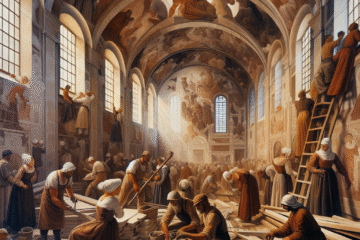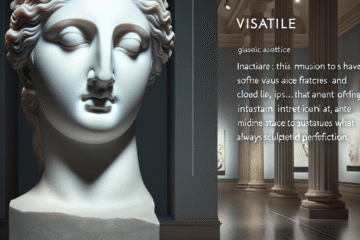Egyptian art is the art of ancient Egypt, a civilization that flourished along the Nile River in what is now modern-day Egypt. Egyptian art is characterized by its distinctive style and iconography, and it has had a lasting influence on the art and design of other cultures throughout history.
Egyptian art is typically divided into three major periods: the Old Kingdom, the Middle Kingdom, and the New Kingdom. The Old Kingdom, which lasted from 2686 to 2181 BCE, is known for its elaborate pyramids and tombs, as well as its sculptures and paintings. The Middle Kingdom, which lasted from 2040 to 1782 BCE, is characterized by a more relaxed and naturalistic style of art, as well as a greater focus on everyday life. The New Kingdom, which lasted from 1550 to 1070 BCE, is known for its more ornate and decorative style of art, as well as its abundance of tombs and temple reliefs.
Egyptian art is characterized by a number of distinct features, including its use of symbolic representation, hierarchical scale, frontal perspective, and use of color and symbolism. In Egyptian art, figures are often depicted in a highly stylized and symbolic manner, with particular emphasis placed on the head and face. The size of figures in a composition is often used to convey their relative importance, with larger figures representing more important individuals or deities. Egyptian art is also notable for its use of frontal perspective, with figures depicted from the front with little attempt at creating the illusion of depth or three-dimensionality. The use of color and symbolism is also an important aspect of Egyptian art, with different colors and symbols representing different deities, concepts, and ideas.
Throughout its history, Egyptian art has had a significant influence on the art and design of other cultures. Its distinctive style and iconography have inspired artists and designers throughout the ages, and its enduring legacy can be seen in the art and design of many different cultures and time periods.
Characteristics of Egyptian art
- Use of symbolic representation
- Hierarchical scale
- Frontal perspective
- Use of color and symbolism
One of the key characteristics of Egyptian art is its use of symbolic representation. In Egyptian art, figures are often depicted in a highly stylized and symbolic manner, with particular emphasis placed on the head and face. For example, the head of a human figure might be depicted with a highly stylized headdress or crown, while the head of an animal might be depicted with exaggerated features such as horns or a long snout. These stylized representations are used to convey the identity and status of the figures depicted, rather than to create a realistic representation of the subject.
Another characteristic of Egyptian art is its use of hierarchical scale, which refers to the way in which figures are depicted in relation to each other in terms of size. In Egyptian art, the size of figures is often used to convey their relative importance, with larger figures representing more important individuals or deities. For example, a larger figure might be depicted standing above or in front of a smaller figure to convey the idea that the larger figure is more powerful or important.
Egyptian art is also notable for its use of frontal perspective, which refers to the way in which figures are depicted from the front with little attempt at creating the illusion of depth or three-dimensionality. This frontal perspective is often used to create a sense of stability and permanence in the compositions, and it is particularly common in relief sculptures and paintings.
The use of color and symbolism is also an important aspect of Egyptian art. Different colors and symbols were used to represent different deities, concepts, and ideas, and they played a significant role in conveying the meaning and significance of the art. For example, the color blue was often associated with the sky and the heavens, while the color red was often associated with the sun and heat. Symbols such as the ankh, the Eye of Horus, and the scarab were also commonly used in Egyptian art to convey specific meanings and ideas.
Overall, the use of symbolic representation, hierarchical scale, frontal perspective, and the use of color and symbolism are all key characteristics of Egyptian art that contribute to its distinctive style and iconography. These characteristics help to convey the meaning and significance of the art, and they have had a lasting influence on the art and design of other cultures throughout history.
Major periods of Egyptian art
- Old Kingdom (2686-2181 BCE)
- Middle Kingdom (2040-1782 BCE)
- New Kingdom (1550-1070 BCE)
Egyptian art is typically divided into three major periods: the Old Kingdom, the Middle Kingdom, and the New Kingdom. Each of these periods is characterized by its own distinctive style and iconography, and they represent different phases in the development of Egyptian art and culture.
The Old Kingdom, which lasted from 2686 to 2181 BCE, is known for its elaborate pyramids and tombs, as well as its sculptures and paintings. This period
is known for the construction of the Great Pyramids of Giza, which were built as tombs for the Pharaohs Khufu, Khafre, and Menkaure. The Old Kingdom is also known for its elaborate tombs, which were decorated with intricate relief sculptures and paintings depicting the deceased and their journey into the afterlife. In terms of sculpture, the Old Kingdom is known for its highly stylized and formalized style, with figures depicted in a highly symbolic and iconic manner.
The Middle Kingdom, which lasted from 2040 to 1782 BCE, is characterized by a more relaxed and naturalistic style of art, as well as a greater focus on everyday life. This period saw the emergence of a more realistic and naturalistic style of art, with figures depicted in a more lifelike and individualized manner. In terms of sculpture, the Middle Kingdom is known for its more relaxed and naturalistic style, with figures depicted in more dynamic and expressive poses. This period also saw the emergence of a greater focus on everyday life, with artworks depicting a wide range of subjects, including domestic scenes, agricultural activities, and religious ceremonies.
The New Kingdom, which lasted from 1550 to 1070 BCE, is known for its more ornate and decorative style of art, as well as its abundance of tombs and temple reliefs. This period saw the construction of many elaborate tombs and temples, which were decorated with intricate relief sculptures and paintings depicting the Pharaohs and their journey into the afterlife. In terms of sculpture, the New Kingdom is known for its more ornate and decorative style, with figures depicted in a more elaborate and formalized manner.
Overall, the three major periods of Egyptian art represent different phases in the development of Egyptian art and culture, and they are characterized by their own distinctive styles and iconographies. The Old Kingdom is known for its elaborate pyramids and tombs, the Middle Kingdom is known for its more naturalistic style and focus on everyday life, and the New Kingdom is known for its ornate and decorative art and its abundance of tombs and temple reliefs.
Major forms of Egyptian art
- Pyramids and tombs
- Sculpture
- Painting
- Hieroglyphic writing
Egyptian art takes many different forms, and it includes a wide range of media and techniques. Some of the major forms of Egyptian art include:
- Pyramids and tombs: Pyramids and tombs are some of the most iconic and enduring forms of Egyptian art, and they are known for their elaborate and ornate decorations. The Great Pyramids of
Giza, which were built during the Old Kingdom, are some of the most famous examples of Egyptian pyramid art, and they are known for their massive size and intricate construction. Tombs, on the other hand, are typically smaller structures that were used to bury the deceased and protect their bodies from the elements. Tombs were often decorated with relief sculptures and paintings depicting the deceased and their journey into the afterlife, and they were designed to be a place of rest and contemplation for the soul of the deceased.
- Sculpture: Egyptian sculpture is known for its highly stylized and formalized style, and it was often used to depict deities, pharaohs, and other important figures. Sculpture was an important medium in ancient Egypt, and it was used to create a wide range of objects, including statues, reliefs, and funerary objects. Egyptian sculpture is characterized by its use of symbolism and its highly stylized representation of the human form, and it has had a lasting influence on the art and design of other cultures throughout history.
- Painting: Egyptian painting is known for its bright and vibrant colors, and it was used to depict a wide range of subjects, including religious themes, scenes from everyday life, and historical events. Egyptian painting is characterized by its use of bold and bright colors, as well as its use of frontal perspective and stylized representation of the human form. Egyptian painting was often done on a variety of surfaces, including papyrus, wood, and walls, and it has had a significant influence on the art and design of other cultures throughout history.
- Hieroglyphic writing: Hieroglyphic writing is a form of writing that was used in ancient Egypt, and it consists of a series of symbols and pictographs that were used to represent words and ideas. Hieroglyphic writing was often used in conjunction with other forms of art, such as sculpture and painting, and it played a significant role in the cultural and religious life of ancient Egypt.
Overall, these are some of the major forms of Egyptian art, and they represent the diverse and creative artistic traditions of ancient Egypt. From the iconic pyramids and tombs to the highly stylized sculpture and vibrant paintings, these forms of art are a testament to the enduring creativity and cultural achievements of the ancient Egyptians.
Influences of Egyptian art
- Influence on other ancient civilizations
- Modern influence on art and design
Throughout its history, Egyptian art has had a significant influence on the art and design of other cultures. Its distinctive style and iconography have inspired artists and designers throughout the ages, and its enduring legacy can be seen in the art and design of many different cultures and time periods.
One of the major influences of Egyptian art is its impact on other ancient civilizations. During the height of its power, ancient Egypt was a major cultural and artistic center, and its art and design practices were widely imitated and adapted by other cultures. For example, the art of ancient Greece and Rome was heavily influenced by Egyptian art, with many Greek and Roman artists and designers incorporating elements of Egyptian style and iconography into their own works. The art and architecture of other ancient civilizations, such as the Persians and the Etruscans, were also influenced by Egyptian art, and this legacy can still be seen in the art and design of these cultures today.
In addition to its influence on other ancient civilizations, Egyptian art has also had a significant impact on modern art and design. The distinctive style and iconography of Egyptian art have inspired artists and designers throughout the ages, and they continue to be a source of inspiration for contemporary artists and designers. The art deco movement of the 1920s and 1930s, for example, was heavily influenced by Egyptian art, with many art deco designs incorporating elements of Egyptian style and iconography. Today, the influence of Egyptian art can be seen in a wide range of art and design practices, from fashion and architecture to graphic design and interior decorating.
Overall, the influence of Egyptian art on other cultures and time periods is a testament to the enduring legacy and significance of this ancient artistic tradition. Its distinctive style and iconography have inspired artists and designers throughout the ages, and it continues to be a source of inspiration for contemporary art and design.
Conclusion
- The enduring legacy of Egyptian art
- The significance of Egyptian art in the history of world art
In conclusion, Egyptian art is a significant and enduring artistic tradition that has had a lasting influence on the art and design of other cultures throughout history. From its iconic pyramids and tombs to its highly stylized sculpture and vibrant paintings, Egyptian art is characterized by its distinctive style and iconography, and it represents a major cultural and artistic achievement of the ancient world.
The enduring legacy of Egyptian art can be seen in its impact on other ancient civilizations, as well as its influence on modern art and design. Its distinctive style and iconography have inspired artists and designers throughout the ages, and it continues to be a source of inspiration for contemporary art and design.
The significance of Egyptian art in the history of world art cannot be overstated. It is a testament to the creativity and cultural achievements of the ancient Egyptians, and it represents an important chapter in the history of world art. Its enduring legacy and influence on other cultures and time periods speak to the enduring power and appeal of this ancient artistic tradition, and it is a testament to the enduring importance of art in human culture and society.


